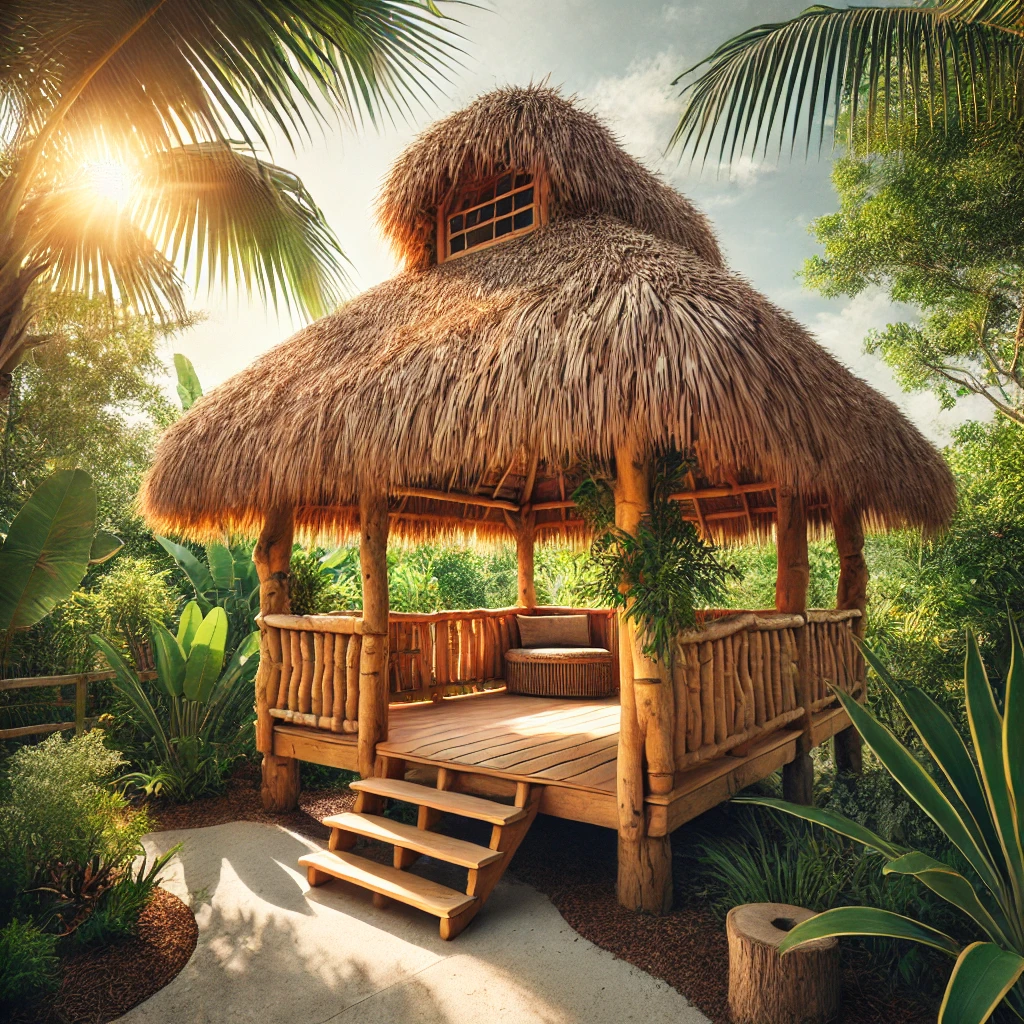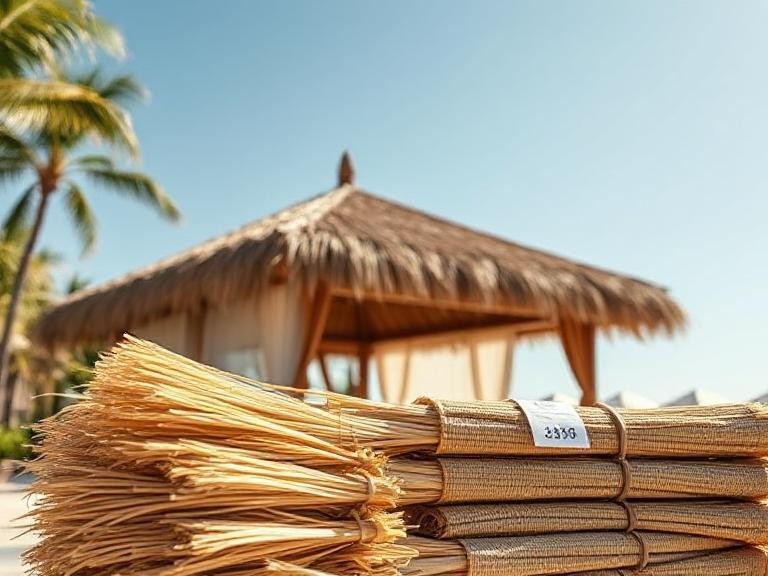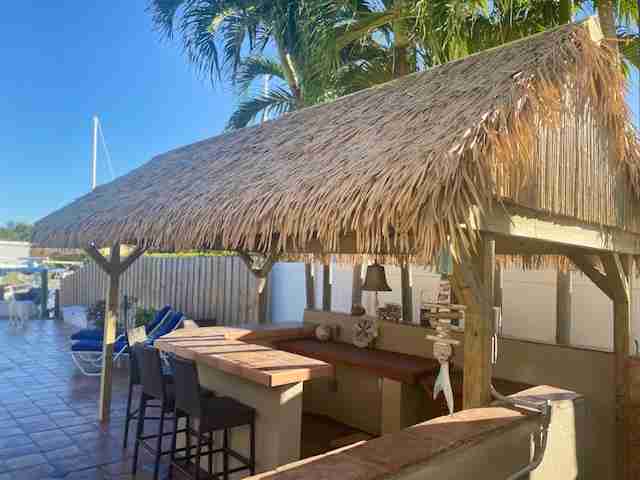
Tristan Ishtar
VP of Sales
Your Chickee hut seemed like the perfect addition to your Florida property – until that natural thatch started showing its age. Now you’re faced with a choice: stick with tradition and keep replacing rotting palm fronds, or make the switch to modern synthetic materials?
It’s not as simple as swapping out the roof – Florida building codes and structural requirements make this decision more complex than most property owners realize.
Whether you’re wrestling with a weathered Chickee hut or planning a new installation, this guide cuts through the confusion around building codes, structural modifications, and the real costs of going synthetic.
Chickee Hut Florida Building Code Requirements If You Have Exemptions
The Florida Building Code provides specific guidelines and exemptions for Chickee hut construction, particularly regarding traditional structures built by Native American tribes. These regulations help preserve cultural building practices while ensuring safety standards are met.
Technically, anyone can build a chickee hut in Florida, but only members of the Seminole or Miccosukee tribes are exempt from meeting Florida Building Code requirements if it’s a traditional Chickee hut.
That means those groups can build one without needing a permit and without adhering to most construction regulations, as long as the structure remains a basic, open-sided thatched hut without electricity or plumbing; however, local zoning laws and property setbacks still apply to all Chickee hut construction regardless of who builds it.
Key permit and documentation requirements include:
- Tribal membership card for exempt constructions
- Chickee hut application for zoning review
- Boundary survey/site plan showing setback and location
- Property owner affidavit regarding utilities
- $175 zoning review and processing fee
- Additional permits for electrical or plumbing features
- Residential building permit application when required
- Comprehensive plan review for non-exempt structures
Chickee Hut Florida Building Code Requirements If You Don’t Have Exemptions
Everyone else in Florida must meet strict requirements designed to protect against hurricanes, flooding, and other natural disasters.
Key Florida building code requirements include:
- Must withstand minimum wind loads of 140-180 mph in most coastal areas
- Structures must be elevated above base flood elevation (BFE) in flood zones
- Impact-resistant windows and doors required in hurricane-prone regions
- Roof materials must meet specific uplift resistance standards
- Structures must maintain minimum setbacks from property lines (typically 5-7.5 feet for side yards)
- Building height restrictions vary by zone but generally max out at 35 feet
- All electrical work must be done by licensed contractors and meet National Electrical Code
- Proper drainage and water management systems required
- Fire resistance ratings required for certain materials and applications
- Americans with Disabilities Act (ADA) compliance needed for commercial structures
- Permits required for most construction, including additions and major repairs
- Professional engineering plans typically required for structures over 400 square feet
- Regular inspections required during construction phases
- Specific foundation requirements based on soil conditions and flood zone
Note: Requirements can vary significantly by county and municipality, so it’s essential to check local regulations in addition to state codes.
Natural vs. Synthetic Thatch Considerations
If you’ve got a Chickee hut and are thinking about transitioning from natural to synthetic thatch, several crucial factors come into play. Tristan Ishtar, vice president of sales at amaZulu, says there is a common misconception about converting traditional Chickee huts.
“People have natural thatch huts that were installed by Seminole Native Americans,” Tristan says. “They’ll want to switch to synthetic because the natural version will rot, but then you have to put them in every 9 inches and that gets pricey.”
The original Chickee hut design incorporates cypress wood framework with horizontal battens spaced at 16-18 inch intervals, supporting natural palm or palmetto thatch. This construction method has been perfected over generations of Native American craftsmanship.
Converting to synthetic materials requires significant structural modifications. “When converting from cabbage palm leaf hut to synthetic, you have to change out the horizontal battens or it’s not going to work,” Tristan says. “It’s a bit more involved than people think.”
The conversion process includes:
- Reducing batten spacing from 16-18 inches to 9 inches
- Reinforcing existing framework as needed
- Installing additional support structures
- Updating attachment methods for synthetic materials
- Ensuring proper ventilation
- Maintaining original architectural characteristics
- Implementing water management systems
- Preserving structural integrity
Should You Change Materials? A Guide to Making the Smart Choice
Converting your Chickee hut from natural to synthetic thatch isn’t a decision to take lightly. While synthetic materials promise durability, the transition involves more than just swapping out materials. Here’s everything you need to consider before making the switch:
- Initial Investment: The upfront costs can be substantial – expect to pay not just for materials, but also for structural modifications like adding extra support beams and reducing batten spacing from 18″ to 9″.
- Long-term Maintenance Savings: While natural thatch needs replacement every 3-5 years, synthetic materials can last 20+ years with minimal maintenance – potentially saving thousands in replacement costs over time.
- Weather Resistance Benefits: Synthetic thatch handles Florida’s harsh climate better than natural materials: it won’t rot in high humidity, resists UV damage, and stands up to tropical storms without degrading.
- Aesthetic Preservation: Modern synthetic materials have come a long way – today’s options closely mimic the look of natural thatch while maintaining their appearance far longer without fading or deterioration.
- Local Code Requirements: Some areas have specific regulations about synthetic materials. You’ll need to verify that your planned conversion meets all local building codes and obtain necessary permits.
- Installation Timeline: A full conversion typically takes 1-2 weeks, depending on your hut’s size and condition. Plan for this downtime and potential weather delays.
- Property Value Impact: While synthetic materials cost more upfront, they can increase property value by reducing maintenance needs and improving durability – particularly important in Florida’s harsh climate.
- Insurance Considerations: Many insurance companies prefer or even require synthetic materials due to their fire-resistant properties and durability – potentially leading to lower premiums.
By weighing these factors against your specific situation – including your budget, long-term plans for the property, and local weather conditions – you can make an informed decision about whether conversion is right for you.
Got Questions About Chickee Huts and the Florida Building Code? We’ve Got Answers
Don’t risk costly mistakes or code violations with your Chickee hut conversion project. amaZulu’s expert team understands both the traditional construction methods and modern synthetic alternatives, ensuring your conversion meets all building code requirements while preserving the authentic aesthetic of your structure.
Our professionals will guide you through the entire process, from initial assessment to final installation, ensuring every detail meets both regulatory requirements and your expectations.
Contact us today to schedule a free consultation and receive a comprehensive evaluation of your Chickee hut conversion needs. Let our expertise transform your traditional structure into a lasting, low-maintenance feature that maintains its authentic appeal for years to come.

Tristan Ishtar
VP of Sales
With over 11 years at amaZulu, Tristan brings deep expertise in tropical building materials and a customer-focused approach. He serves as a trusted consultant for architects and designers, providing expert guidance without high-pressure sales.





